This ongoing study seeks to address a gap in language teaching research on pre-service teacher noticing. Although teacher noticing has been investigated in other fields, and the novice-expert distinction in language teaching appears partly to rest on the idea that experienced teachers are more efficient “noticers”, questions about which factors may influence noticing and how it develops among teacher trainees have only recently begun to be asked. This report describes a task-based study carried out with undergraduate students enrolled in a teacher-training course. In dyads, one student was assigned to the teacher role and the other to the student role. They then completed a series of pedagogic tasks. The study was designed to gain insight on the potential influence of two factors: perspective and task complexity. Immediately upon completion of each task, stimulated recall methodology was used to probe noticing among the teacher participants. Preliminary results suggest that task complexity may influence the number of recall comments. Moreover, this report demonstrates how a triangulated, mixed methods approach can offer insight into pre-service teacher noticing. Such results may foster understanding of the teacher’s role in task-based language teaching.
Key words: TBLT, ESL, EFL, TESOL
The senses are the foundation of learning and teaching. This observation applies to many species, but in human beings, teaching is greatly enhanced by language use, which means that hearing and sight, especially, give rise to relevant conscious experiences. Within language teaching, when teachers become consciously aware of their students’ use of spoken or written language, and combine this awareness with pedagogic reasoning, they are engaged in a form of professional noticing [2, 26] that is relevant to their work. They can act on this noticing in ways that seek to foster the development of a second or foreign language. At present, very little research directly addresses the topic of language teacher noticing, despite its ubiquity in classrooms. This paper seeks to help fill that gap by focusing on certain methodological issues in language teacher noticing research. In this report, I first argue that retrospective methods of studying teacher noticing call for consideration of the potential influences of perspective and task complexity. Previous research suggests that these factors may shape what preservice teachers perceive as relevant to instruction and learning in second or foreign language contexts. Then, I show how the careful selection of data sources might support this type of research.
What characteristics or qualities of language teachers define them and inform their work? The field of second language teacher education has offered many answers to this question. They include, among others, teacher autonomy [10], teacher cognition [3], teacher beliefs, assumptions, and knowledge [25], teacher expertise [24], teacher identity [3], teacher reflection [7], and teacher vision [5]. Each of these areas represents a distinct, complementary stance on how teachers stimulate growth in their students and maintain their own growth as professionals through engagement. Furthermore, the origins and applications of these constructs extend far beyond the field of language teaching [7].
In line with this trend, the construct of teacher noticing, which is the focus of this report, has been developed and researched mainly outside of language education, in the fields of math and science education [17]. Based on these studies, teacher noticing appears to have potential to offer insight on the qualities that enhance language teacher performance and foster their professional development. It also creates theoretical links that can help us understand the relationships between constructs already defined in language teacher education. For instance, the novice-expert distinction in language teaching appears partly to rest on the idea that experienced teachers are better at selectively attending to classroom events [24], hence they are more efficient “noticers”.
Research on language teacher noticing is scarce, but it has raised questions that inform the current investigation. In the first study to address this topic, Jackson and Cho [12] defined language teacher noticing as an awareness of features of classroom interaction that may influence learning. They aimed to develop procedures for investigating it, to describe its occurrence, and to identify themes within it. They recruited eight teachers enrolled in an undergraduate course on second language teaching, who each conducted a teaching demonstration and participated in a subsequent stimulated recall interview, in which they reported what they noticed while teaching their demonstration. Regarding the methodology, one innovation in the study was the use of split-screen videos as stimuli. That is, during the recall interviews, participants watched a video compiled from two simultaneous recordings taken from cameras positioned in different locations—one showing their teaching as seen from the back of the room and another showing it from the front of the room. These two opposing angles appeared side by side on a computer screen and were accompanied by a single audio track. This enhancement was intended to improve memory recall. Moreover, teachers in this study designed their own lesson plans and teaching materials, which inevitably led to variation in what they reported on during the interviews. These methodological decisions raise further questions about the role of the stimuli and tasks used in language teacher noticing research (see below).
As for the results, Jackson and Cho [12] found that all teachers reported noticing. This noticing related to lesson plans versus classroom realities, spontaneous action, and individual student contributions. However, there was, in addition to these findings, a significant difference in the number of noticing instances across two groups: those participants who joined the recall interview within two days of their demonstration and those who joined later. Therefore, when using stimulated recall methodology to elicit noticing, timing appears to be a major concern. For further commentary on the use of this methodology in teacher cognition research, see Borg [3, 244]. In hindsight, this study, which employed an observational design, brings to light some methodological issues that could perhaps be addressed though additional, experimental research.
The first methodological issue raised concerns perspective. In the literature on teacher noticing, Miller [16] has asserted that perspective may make a key difference when training teachers to notice. This refers to the visual experience of recalling an event, either from a field or an observer perspective. In the former, one recalls the experience using a first-person viewpoint, according to his or her field of vision at the time of the original experience. In the latter, one recalls the experience from a third-person viewpoint, as if he or she were an outside observer who had witnessed the event. Miller cites evidence that skill acquisition during training differs according to the perspective adopted, and the nature of this distinction and its potential influence on memory recall is supported by other researchers, as well [15]. When using stimulated recall methodology, then, it may be necessary to consider how decisions to prompt recall from the field versus the observer perspective might influence results. For instance, videobased stimuli can be created using a field perspective, an observer perspective, or a combination of both these perspectives (as in the case of Jackson & Cho [12], see above). Regardless of what the participant noticed at the time of the event, which is the main variable of interest, these options could prompt individuals to recall particular facets of their experience that are filtered through the lens of the perspective(s) they adopt. For instance, McIssac and Eich [15] found that participants reported significantly more affective reactions when asked to recall using a field perspective and, conversely, significantly more comments on personal appearance when asked to adopt an observer perspective. No second language research (to my knowledge) has sought to systematically investigate the elicitation methods used during stimulated recall according to perspective, though this could influence the outcomes of studies on language teacher noticing.
The second methodological issue raised in this paper concerns task. Research on task-based language teaching (TBLT), including implementations in EFL and ESL settings, has greatly expanded in its theoretical, contextual, and methodological scope [11]. Nonetheless, one unresolved issue in TBLT concerns the sequencing of tasks in a curriculum. In response to this issue, Robinson and colleagues have claimed that the basis of sequencing should be task complexity, which is distinct from task difficulty and task conditions in his taxonomic framework. Robinson’s Cognition Hypothesis is a series of related claims which predict that more complex tasks will yield more accurate and complex (but less fluent) production, more interaction, more noticing and uptake, and enhanced processing and memory retention [20, 94–98]. These claims have been investigated, with researchers, in general, finding some support for them, under monologic and dialogic task conditions (see [13], for a synthesis of the former).
Importantly, if task complexity is the primary impetus for language development in task-based instruction, then it is crucial to understand not just the design features that underpin complex tasks and how they impact learner production, interaction, noticing, and processing/retention, but, in addition, how they may influence teacher cognition. Under one recent view, tasks are to be seen as spaces within which both the teacher and the learners operate. For instance, research has illustrated how teachers work with design specifications when making in-the-moment decisions about how to transform a prospective workplan into a dynamic workplan [13]. Thus, we should probably expect design features, which include various dimensions of task complexity, to affect teacher noticing, or the teachers’ awareness of ongoing interaction that may influence learning. In fact, some studies have begun to look into how task complexity is perceived by language teachers ([18], [22], [24]). The present study extends this line of research by situating the question of how task complexity influences teacher cognition within an agenda that seeks to understand pre-service language teacher noticing.
Based on the foregoing literature review, and considering the importance of these issues for future efforts within teacher training, three research questions informed this report. First, does the perspective employed when pre-service EFL teachers recall task performances (i.e., from a field vs. observer perspective) influence the amount of recall comments they report? Second, does task complexity (i.e., simple vs. complex) influence the amount of recall comments that these participants report? Finally, what features of interaction do participants attend to in their recall comments?
Methods
Participants
This brief report is based on a study that is currently in progress. In line with the overall purpose of the research, which is to understand teacher noticing during TBLT, MGSPU students, who were in their 3rd or 4th year of undergraduate study, and were enrolled in the teacher training course at the university were considered eligible to participate. Based on these criteria, participants were recruited through announcements in several sections of the English Language Teaching Methodology course. The study announcement informed them of the requirements, as well as the topic of the research (“teacher noticing”) and specified that they would be asked to take part in pair work for 90 minutes. These sessions were conducted in the researcher’s office at a mutually convenient time.
Twenty-four participants joined the study. Of these, 11 were male and 13 were female. Their average age at the time of the study was 21 years old. There were 16 3rd year and 8 4th year students. They were predominantly majoring in English, but two participants were majoring in Africo-American Studies and one was majoring in Intercultural Communication.
Procedure
Each session began with the researcher greeting the two participants, in his office, and distributing a consent form explaining the study’s purpose and procedures, as well as a survey to collect biodata. After collecting these documents, the participants were assigned to roles using a coin toss. They then read instructions pertaining to their role as either speaker/teacher or listener/student. Next, the participants carried out the first of four tasks (described below), seated across from each other at a table. The task performances were recorded using a high-definition video camera. A time limit of five minutes was set for each task. Once finished, both participants completed a task difficulty survey (not reported on here). Then, the researcher excused the participant in the student role, transferred the video data to a computer, and invited the teacher participant to sit at the desk with the computer. At that point, the teacher participant was trained to carry out the stimulated recall interviews. That is, he or she read a series of PowerPoint slides with instructions (in Russian) and watched a video demonstration of a teacher thinking aloud (for further details of this methodology, see [9]). After they had gone through these training materials, the researcher asked if the teacher participant had any questions. Participants were encouraged to use either English or Russian, whichever they felt would be easier, while thinking aloud. Then, the researcher asked the participant to play the video and begin thinking aloud. During this time, he or she wore a set of headphones in order to reduce the amount of noise in the room. The think-aloud comments were recorded using a Linear PCM audio recorder placed on the desk nearby. Upon completion of the teacher’s recall interview, the student participant was called back into the room. Then, the two participants repeated the above sequence of procedures for the three remaining tasks (minus the think-aloud training). At the end of the session, the researcher asked if there were any questions and gave the participants information regarding payment. The reimbursement offered for the 90-minute session was 500 rubles per hour.
Experimental conditions
The present study built on the literature regarding the Cognition Hypothesis (e.g., [1], [19], [20]) by manipulating three design features in order to create a set of simple and complex tasks. These were planning time, number of elements, and familiarity. Specifically, pre-task planning time was manipulated by giving participants three minutes to look up and write down any words or phrases that they thought might be useful prior to simple tasks. An electronic dictionary was provided for this purpose. No planning time was allotted prior to complex tasks. The number of elements was increased from simple to complex tasks by using task materials (i.e., maps) depicting a larger number of physical referents and route directions needing to be followed. Finally, the simple task materials showed familiar locations, including the MGSPU campus and station nearby, whereas the complex task materials depicted locations that were not intended to resemble any specific location in the real world, but instead showed a generic shopping area and a museum complex.
In addition, I operationalized the perspective manipulation by having the participants alternate seats. That is, the stationary camera was either behind the student facing towards the teacher (observer perspective) or behind the teacher facing towards the student (field perspective). Thus, while viewing the video, the teacher either saw his or her own face, or, alternately, saw his or her partner’s face, respectively. Participants were asked to change seats in between doing the tasks, as called for by the study design (see below).
For each of the four tasks, the teacher was instructed to tell his or her partner where to go on a map. The teacher’s map version had the route marked, including the start and finish point. The student was told to follow his or her partner’s directions and check to ensure understanding. They were asked to draw a line on the map according to these directions. Appendices A and B show the complex museum task, student and teacher versions, respectively.
Design and analyses
To recap, this report was based on an ongoing, two-factor, repeated measures experiment. These factors each had two levels: perspective (field versus observer) and task complexity (simple versus complex). This yielded four possible conditions to be tested during the experiment: field-simple, field-complex, observer-simple, and observer-complex. The teacher participant led a different version of the map task under each of these conditions. This study employed a counterbalanced design using Latin squares to control for the effect of order. The teachers’ comments during the subsequent recall interview were transcribed and translated by a student assistant. In this report, these teacher comments constituted the dependent variable.
Following a mixed methods approach (e.g., [4]), in addition to these quantitative results, in order to explore the features of interaction that participants responded to in their comments, additional, qualitative analyses were pursued. These incorporated the recall interview comments, the actual task performance (recorded on video), and the student participants’ completed maps, which were collected after each performance. These multiple sources were selected to allow for triangulation and potentially richer insight into the interactive task processes surrounding the teachers’ noticing (see Table 1). Task interaction data was transcribed using conventions based on those used in conversation analysis, including a separate tier for embodied actions, indicated by the + symbol (see, e.g., [14]).
Table 1
Data triangulation in this study
|
Collection method |
Data source |
|
Teacher and Student |
|
Student |
|
Teacher |
Results
Quantitative results
These results are based on the number of comments provided by the 12 teachers under each condition. First, the overall averages for each condition are presented. Regarding the task complexity manipulation, there were more comments during complex task conditions (M = 10.12, SD = 2.80) than simple task conditions (M = 7.58, SD = 3.16). Regarding the perspective manipulation, there were slightly more comments under the field condition (M = 9.13, SD = 3.23) than under the observer condition (M = 8.58, SD = 3.24). To look more closely at each of the four experimental conditions, the following averages were calculated: complex task-field perspective (M = 10.33, SD = 2.29), complex task-observer perspective (M = 9.92, SD = 3.23), simple task-field perspective (M = 7.92, SD = 3.57), and simple task-observer perspective (M = 7.25, SD = 2.65). These are plotted in Figure 1, which indicates average stimulated recall interview comments by task complexity and perspective. As shown in the graph, the complex tasks generated more comments, as did the field perspective (although its effect was less pronounced). As can be seen, there was no interaction between task complexity and perspective.
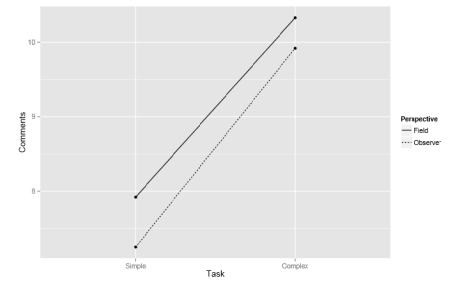
Fig. 1. Average number of stimulated recall interview comments by task complexity and perspective
Quantitative results
Here, qualitative results are presented to illustrate the kinds of comments made and the interactions which triggered them. First, the entire data set, consisting of comments from the 12 teacher participants, was reviewed for representative comments from the stimulated recall interviews. However, these comments, in the absence of additional data, do not tell the entire story. It was considered important, therefore, to analyze relevant during-task talk involving both the teacher and student participants, which served as a stimulus for the recall (see [9]), and also to inspect task outcomes based on materials submitted by the student participant. For the purpose of this preliminary report, two examples are provided: one from a simple task and the other from a complex task.
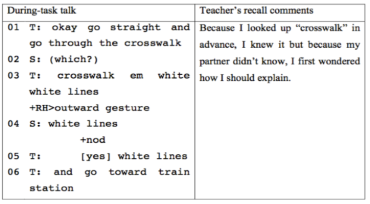
Fig. 2. Simple task (P#3, Station task)
To begin, in Fig. 2, During-task talk, the teacher was clear in using the phrase ‘through the crosswalk’ to indicate the path and location of movement in Line 1, as the crosswalk was marked by several lines on both versions of the map. When the student indicated trouble understanding, the teacher repeated the word and elaborated (‘white lines’), including a gesture to provide more information. The student then repeated ‘white lines’ and, in doing so, signaled understanding non-verbally by nodding. The teacher then continued with giving directions in Line 6. It was clear from an inspection of the student’s submitted map that this part of the instruction had been conveyed effectively. The stimulated recall data (Teacher’s recall comments) reveal the teacher’s thoughts upon viewing this exchange moments later. This indicates that she had looked up the word ‘crosswalk’ during the pre-task planning time. She furthermore attended to the student’s reaction to it, interpreting this as a lack of understanding, and wondered how to explain it here. As already noted, the explanation that followed was effective in establishing comprehension and success on this part of the task.
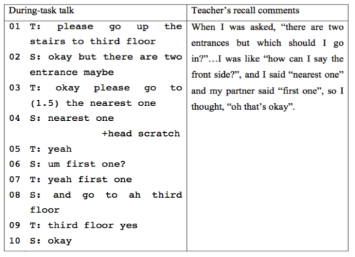
Fig. 3. Complex task (P#10, Museum task)
Next, in Fig. 3., During-task talk, the teacher gave a clear instruction to ‘go up the stairs to the third floor’ in Line 1. The student responded affirmatively to this instruction, but pointed out that the building had two entrances. The teacher then instructed the student to ‘go to the nearest one’, hesitating during this utterance. This use of relative proximity, though natural, is indeterminate, thus it needs to be inferred that the teacher meant the nearest entrance to the front side of the building (see recall comment) or the nearest entrance to the stairs (see Line 1). However, the student did not seem to understand this immediately, repeating ‘nearest one’ and scratching his head (Line 4), then asking if this referred to the first entrance to the building (in the direction in which he had been told to move). After the teacher confirms that ‘first one’ is a suitable description of the entrance (Line 7), the interaction proceeds smoothly with the student continuing to the third floor. The student’s map showed that these directions were understood as intended. In this case, the number of elements in the task may have contributed to the difficulty in Lines 2–7 by leading to diverging conceptualizations of space [6]. The teacher’s recall comments indicate that he had paid close attention to the student’s question, considered alternative spatial expressions to improve comprehension, and decided, based on the student’s suggestion, that ‘first one’ and ‘nearest one’ were equally acceptable.
Discussion
To summarize these preliminary results, the tasks used in this study appeared to influence the number of recall comments. There were more comments when teachers were commenting on complex tasks than on simple tasks (see Figure 1). This result is to be expected, based on the assumption that the claims of the Cognition Hypothesis [20] may extend to second language teachers. That is, tasks designed to be more complex (in terms of planning time, number of elements, and prior knowledge) should yield greater noticing amongst learners and teachers, as long as they are engaged in interaction. This follows from a view of TBLT that sees a prominent role for the teacher in shaping task performance and outcomes (e.g., [25]). In the present study, the interlocutors, who were undergraduates enrolled in a teacher-training program, were randomly assigned to teacher and student roles, and carried out a series of tasks together. The teacher comments (during the stimulated recall interviews) are, therefore, assumed to represent the pedagogic thinking of pre-service teachers. It is further argued that these comments may reveal their in-the-moment awareness of features of task-based interaction that can influence learning (cf. [12]).
On the other hand, the perspective taken, whether field or observer, did not yield a large quantitative difference in the number of comments. This was unexpected because perspective was thought to be a potentially important factor, based on the literature on teacher noticing in general education [16]. However, it needs to be pointed out that the differences which emerged from experimental manipulations of perspectival memory in prior research were qualitative, rather than quantitative, differences [15]. Thus, this ongoing study cannot currently offer any conclusive insight into the issue of whether perspective influences pre-service language teacher noticing. Additional analyses of the dataset need to be conducted before any firm conclusions can be reached.
Concerning the effect of task complexity, features of the interaction in Excerpt 1 showed a teacher’s success in coping with an unknown lexical item (“crosswalk”) during a simple task, which provided time to prepare in advance. Excerpt 2 showed the teacher deploying linguistic resources spontaneously during interaction, this time to reorient to the student’s conceptualization of the task input. In these ways, simple and complex tasks seem to afford similar challenges but also different opportunities for teacher noticing. These results suggest that task complexity may make a difference in the amount and kind of interactional features that teachers notice. They can also show, perhaps in some detail, the interactional abilities necessary for teachers to effectively implement TBLT.
This paper was concerned primarily with the methodology used to study language teacher noticing. It builds on observational research on this construct [12] by employing an experimental design, which can offer clearer insight into task complexity and perspective. An additional advantage of this study is that recall interviews were conducted immediately after the teachers led the students through the tasks, thereby mitigating the problem of participants forgetting details of what they noticed. Furthermore, a mixed methods approach incorporating analyses of during-task conversation, task outcomes, and recall interviews can support a more thorough unveiling of what teachers see and hear, and how they respond, during engagement in task-based interaction. Subsequent steps in this ongoing research project will involve recruiting more participants, further analyses of the task and recall data, and examination of an additional data source (i.e., task surveys).
The importance of studying language teacher noticing lies in its potential to enhance second language teacher education. The bridge between being an undergraduate student, and a learner of another language, such as English, and being a teacher of that language, is an important transition in the lives of many individuals. The participants in this study are no exception. During their training to become teachers, their identities, knowledge, skills, and self-direction undergo transformation. These changes, even before they become licensed teachers, may influence what they notice as professionals. It remains an open question how noticing evolves into a professional skill that is highly sophisticated in experts. To say the least, what pre-service teachers notice, during classroom tasks, teaching demonstrations, or participation in task-based studies such as this one, may inform their ongoing development. Therefore, it is worthy of continued investigation, particularly if noticing helps teachers to effectuate contemporary practices in language education, such as TBLT.
Appendix A
Museum task (Student version)
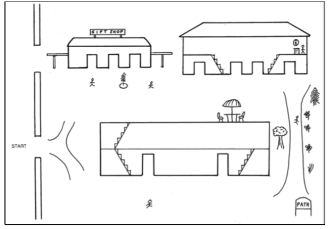
Appendix B
Museum task (Teacher version)
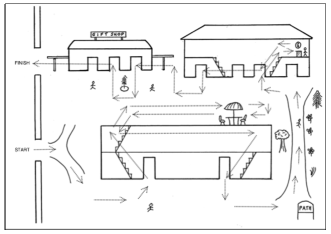
References:
- Baralt, M., Gilabert, R., & Robinson, P. (2014). Task sequencing and instructed second language learning. London, UK: Bloomsbury.
- Baralt, M., Harmath-de Lemos, S., & Werfelli, S. (2014). Teachers’ application of the Cognition Hypothesis when lesson planning: A case study. In M. Baralt, R. Gilabert & P. Robinson (Eds.), Task sequencing and instructed second language learning (pp. 179–206). London, UK: Bloomsbury.
- Borg, S. (2015). Teacher cognition and language education: Research and practice. London, UK: Continuum.
- Brown, J. D. (2014). Mixed methods research for TESOL. Edinburgh, Scotland: Edinburgh University Press.
- Dörnyei, Z., & Kubanyiova, M. (2014). Motivating learners, motivating teachers: Building vision in the language classroom. NY, NY: Cambridge University Press.
- Evans, V., & Green, M. (2006). Cognitive linguistics: An introduction. Mahwah, NJ: Lawrence Erlbaum.
- Farrell, T. S. C. (2015). Promoting teacher reflection in second language education: A framework for TESOL professionals. NY, NY: Routledge.
- Freeman, D. (2016). Educating second language teachers. Oxford, UK: Oxford University Press.
- Gass, S. M., & Mackey, A. (2017). Stimulated recall methodology in applied linguistics and L2 research (2nd Edition). NY, NY: Routledge.
- Jackson, D. O. (in press). Teacher autonomy. In Liontas, J. (Ed.), The TESOL encyclopedia of English language teaching. Wiley/TESOL.
- Jackson, D. O., & Burch, A. R. (2017). Complementary theoretical perspectives on taskbased classroom realities. TESOL Quarterly, 51, 493–506.
- Jackson, D. O., & Cho, M. (2016). Language teacher noticing: A socio-cognitive window on classroom realities. Language Teaching Research. Advance online publication. doi: 10.1177/1362168816663754.
- Jackson, D. O., & Suethanapornkul, S. (2013). The Cognition Hypothesis: A synthesis and meta-analysis of research on second language task complexity. Language Learning, 63, 330–367.
- Lee, J., & Burch, A. R. (2017). Collaborative planning in process: An ethnomethodological perspective. TESOL Quarterly, 51, 536–575.
- McIsaac, H. K., & Eich, E. (2002). Vantage point in episodic memory. Psychonomic Bulletin & Review, 9, 146–150.
- Miller, K. F. (2011). Situation awareness in teaching: What educators can learn from video-based research in other fields. In M. G. Sherin, V. R. Jacobs & R. A. Philipp (Eds.), Mathematics teacher noticing: Seeing through teachers’ eyes (pp. 51–65). NY, NY: Routledge.
- Mason, J. (2002). Researching your own practice: The discipline of noticing. NY, NY: Routledge.
- Révész, A., & Gurzynski-Weiss, L. (2016). Teachers’ perspectives on second language task difficulty: Insights From think-alouds and eye tracking. Annual Review of Applied Linguistics, 36, 182–204.
- Robinson, P. (2011). Second language task complexity, the Cognition Hypothesis, language learning, and performance. In P. Robinson (Ed.), Second language task complexity: Researching the Cognition Hypothesis of language learning and performance (pp. 3–37). Amsterdam, NL: John Benjamins.
- Robinson, P. (2015). The Cognition Hypothesis, second language task demands, and the SSARC model of pedagogic task sequencing. In M. Bygate (Ed.), Domains and directions in the development of TBLT (pp. 87–121). Amsterdam, NL: John Benjamins.
- Polio, C., Gass, S., & Chapin, L. (2006). Using stimulated recall to investigate native speaker perceptions in native-nonnative speaker interaction. Studies in Second Language Acquisition, 28, 237–267.
- Schack, E. O., Fisher, M. H., & Wilhelm, J. A. (2017). Teacher noticing: Bridging and broadening perspectives, contexts, and frameworks. Cham, Switzerland: Springer.
- Sherin, M. G., Jacobs, V. R., & Philipp, R. A. (2011). Mathematics teacher noticing: Seeing through teachers’ eyes. NY, NY: Routledge.
- Tsui, A. B. M. (2003). Understanding expertise in teaching: Case studies of ESL teachers. Cambridge, UK: Cambridge.
- Woods, D. (1996). Teacher cognition in language teaching: Beliefs, decision-making and classroom practice. NY, NY: Cambridge University Press.







